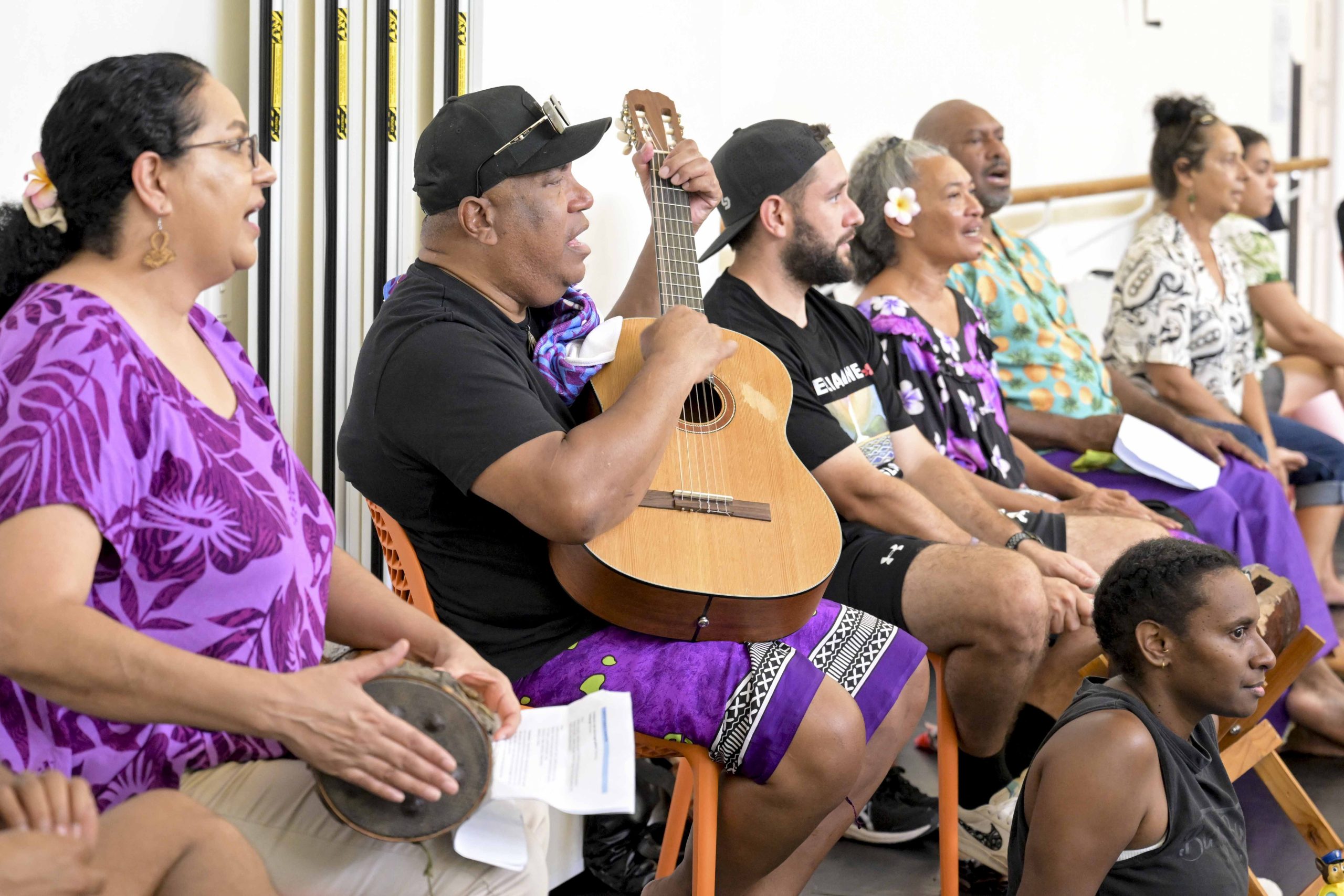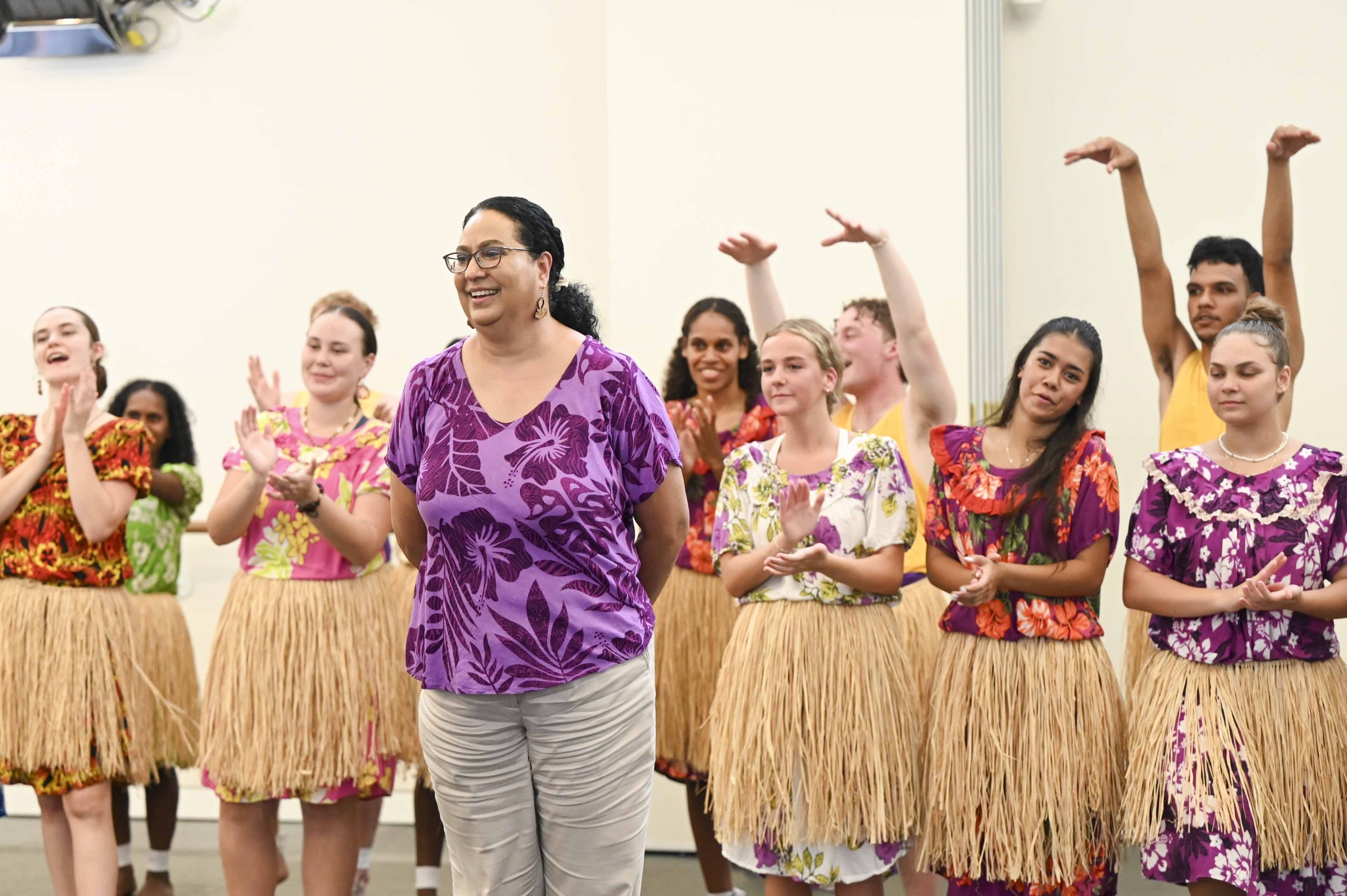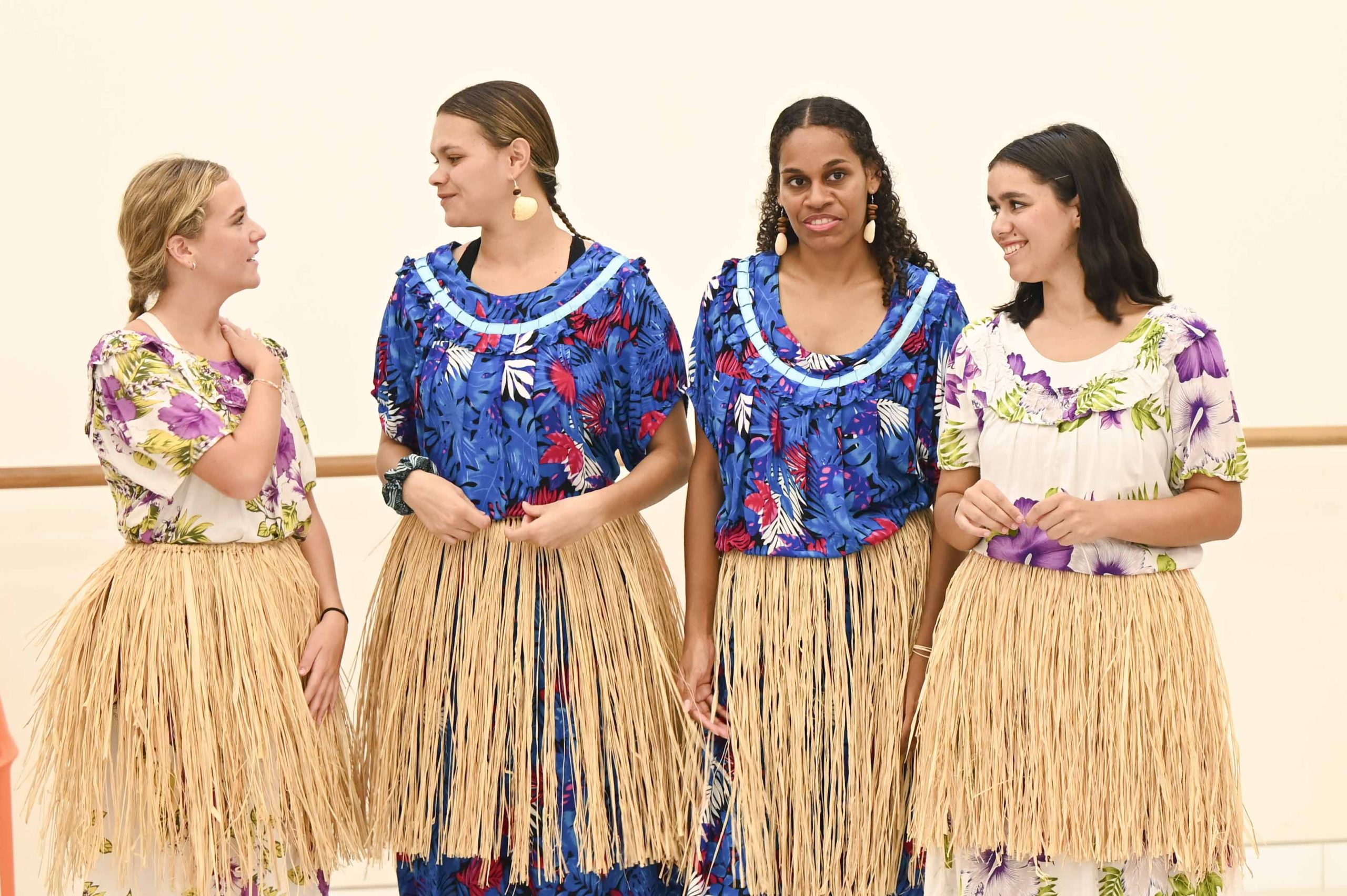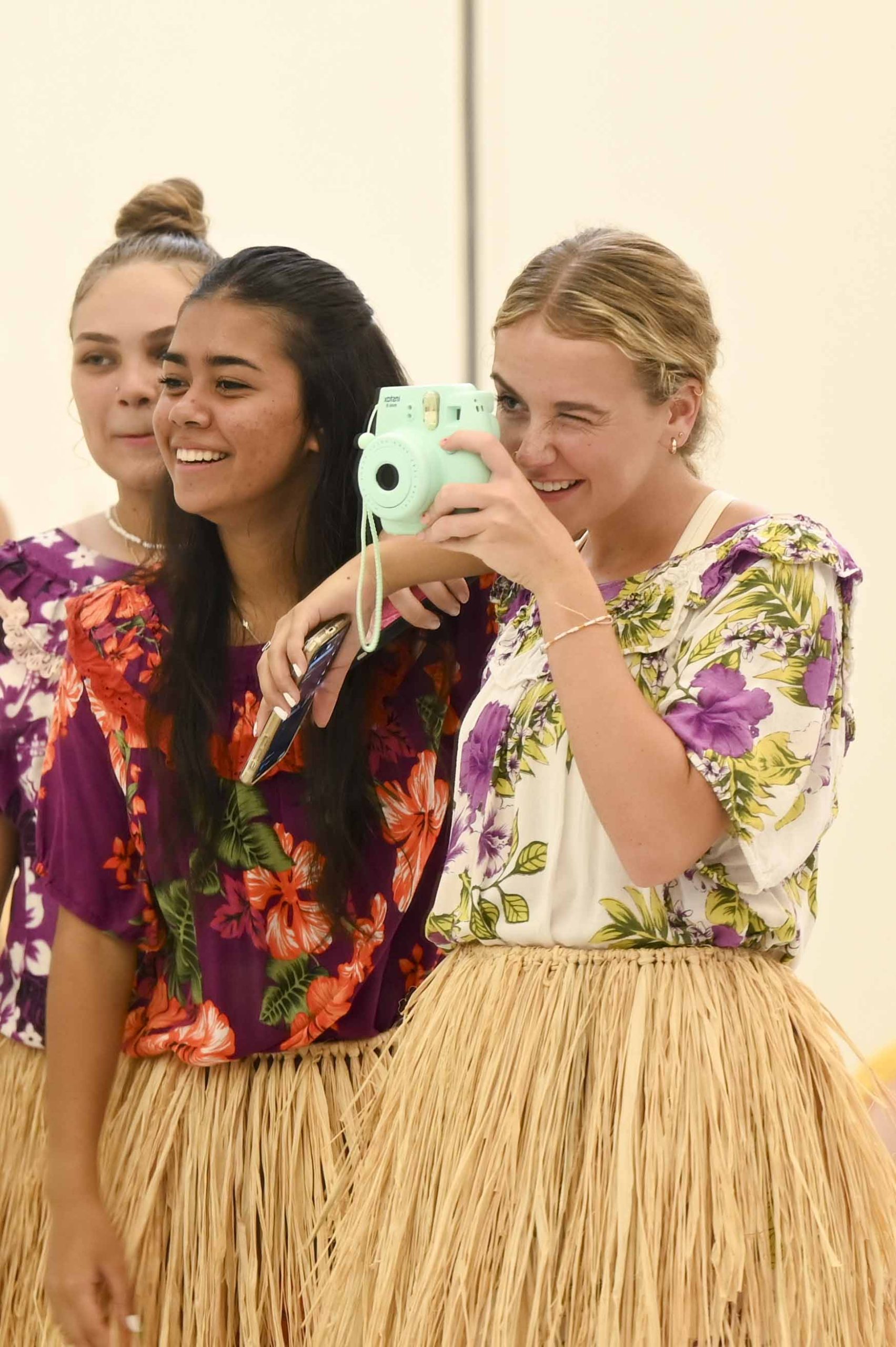
Earlier this month, we hosted our 2024 Onsite Cultural Residency, welcoming back Cultural Tutors Dujon Niue and Jeanette Fabila. They were joined by Cultural Tutors Helen Anu and Masepah Banu to share cultural learning, songs and dances from Mua Island in the Torres Strait.
As part of the Cultural Residency program, NAISDA students will travel to Mua Island this August to expand and continue these learnings, guided by the generosity of Dujon and the local community.
We had the opportunity to connect with Helen and Masepah, to delve deeper into this year’s onsite Cultural Residency. Join us as we explore their experiences and reflect on their time at NAISDA.
Tell us a bit about yourselves and your connection to NAISDA.
Masepah: My full name is Masepah Banu. All my family come from Boigu and Mua of the Torres Strait Islands. Uncle Dujon invited Helen and I to workshop with the NAISDA Developing Artists this week.
Helen: My name is Helen Anu, I also have a connection to Uncle Dujon as well. We’ve performed together over the years, but also communally we have kinship ties as well. He invited both of us because of our performing background and our cultural ties. We’re here to support him throughout the Cultural Residency.
You’re at NAISDA for the week-long Onsite Cultural Residency, and it’s your first time as NAISDA Cultural Tutors. Can you tell us what this means and what your roles are throughout the week?
Helen: Primarily, we’re under the direction from our Elder, Uncle Dujon. We’re honouring his work, so that means his songs that he’s composed and the dances that he’s choreographed. My role is a singer, and to make sure that the students are learning the language linguistically. They are trained to learn dances from different Aboriginal and Torres Strait Islander communities. Whether it’s North East Arnhem Land, or other communities, they are learning language which is totally foreign to them.
So, my role as the singer is to ensure that they are singing the language correctly and represent the story that the dance is about.
Masepah: My role is to ensure that the students have correct dancing technique and posture.
Helen: It’s maintaining the true integrity of what the stories in those songs are telling, and that they honour Uncle Dujon’s work, which reflects his heritage from the Island he is from. We’re training the students vocally because they’re being assessed on how they apply themselves to learn the language and how to dance and perform it too.

Why do you think learning and sharing from Knowledge Holders like NAISDA’s Cultural Tutors is so important?
Helen: No matter what community the students come from, I think learning from a Knowledge Holder disciplines you to set yourself up in the future. It builds a foundation based upon respect. You learn, listen, observe quietly. You carry all of these fields of discipline and apply it in your dance. It really builds and strengthens your identity, and even though it’s not your culture, it gives you a sense of identity and pride. You learn at the end of it what you’re capable of.
Masepah: I think that it also brings a sense of discipline and respect, from the Elders. Back in the day, the Arnhem Land Cultural Tutors showed me the respect and discipline as I listened to their stories and the technique in their dances. Discipline comes with a sense of pride, belongingness and a sense of achievement.
Helen: When you sing the songs, learn the language, it’s about the continuity of maintaining the oral history.
What’s it like being back at NAISDA? What’s changed?
Masepah: It’s been amazing to see how much NAISDA has grown from when I trained here. At that time NAISDA was based in Glebe, Sydney. Today the NAISDA Kariong campus is a culturally appropriate venue for students, embedded with all these Aboriginal language words from the Darkinjung mob here. It’s a very beautiful place.
Helen: For many years, maybe 10 to 20 years ago, people auditioning for NAISDA from the Torres Strait community, whether it be the mainland community or the community out on the Islands, would be following the Elders who went before them – like a stepping stone.
On Monday when I came in, I also noticed how much younger the dancers are getting. On Cultural Residency here I can already see how the young people are, their identity is strong and connection to other members of the community is amazing.

How do you find inspiration and creativity in your daily lives?
Helen: I think sometimes you just have to slow down, as sometimes inspiration will come at the most random times and when you least expect it – you’ll find a creative lightbulb moment. You also have to listen to, sit with, and trust your inner voice. Quite often that’s connected to how you were raised, and who you were surrounded by in community. That’s what inspires me anyway.
Masepah: My family, my partner and Uncle Dujon inspire me. And also NAISDA inspires me if I can be blunt, because I’ve been involved with its history since 1994 until now, in 2024.
Helen: There are also NAISDA graduates like Genoa Gela, who just finished Sydney Festival with her own production Gurr Era Op and an all-Torres Strait Islander female cast – they’re all graduates from NAISDA. Now she inspires me. One of her co-performers, Aba Bero and Berthalia Selina Reuben who are trainers here, they inspire me too.
What role do you think cultural and creative organisations like NAISDA play today in Aboriginal and Torres Strait Islander culture and learning?
Helen: I think it’s really impressive the longevity of NAISDA, from the early days of AIDT (Aboriginal Islander Dance Theatre – the early performing arm of NAISDA) to where NAISDA is now, and how it all evolved. It has a contemporary space now, and over the years the curriculum has changed and developed – as well as the key foundation, Aboriginal and Torres Strait Islander cultures. That’s that foundation for identity. Having a place like this is vital for young people. Perhaps young people who have been disengaged from culture for whatever reason, and want to be reengaged – having the opportunity for a cultural institution and learning place like NAISDA is really important. There’s also a diverse range of people who come to NAISDA to learn together communally. Having that communal aspect really builds spirit and makes you want to learn more too.
Masepah: NAISDA is an organisation that holds our cultural knowledge and practices from remote communities that share their culture with NAISDA, so that it is passed along to the next generation, keeping culture alive. It also makes me really proud as an Elder when I see these students here performing with their dances.

What opportunities and challenges do you see emerging for careers and performances in the Aboriginal and Torres Strait Islander creative and cultural sector?
Helen: There’s a lot of opportunity, not just in dance, but also the production elements of coming to a performing arts institution. I acknowledge that there’s probably young people who have multiple skills not just with dancing, but whether it’s with costuming or lighting, there’s all sorts of areas in the performing arts that Developing Artists could branch out into. There are people who have graduated NAISDA and gone into professional dance companies immediately, or auditioned and got into performing around the country and overseas – Masepah’s an example of that.
Masepah: With that foundation of NAISDA, it taught me the discipline, the culture. I’ve actually used that to perform in Australia during NAIDOC Week and to perform overseas with my fellow Aboriginal and Torres Strait Islander dancers. We performed in Hawaii, in China and we went to Moscow, to show our Aboriginal and Torres Strait Islander cultures to those international audiences.
All the modules they teach at NAISDA are good guiding principles through life.
What advice would you offer a young Aboriginal or Torres Strait Islander artist or performer beginning their journey into dance, performance and the creative industries?
Masepah: Just be patient, listen, learn and apply yourself. Be patient for the next two to four years to learn and really apply yourself.
Helen: I think it’s important that you make sure to connect and reach out, especially as homesickness is a real thing. When you’re looking to enter a career, keep in mind that there’s distance – and this distance is often the journey itself.
Also, have a genuine passion and be prepared for other methods of teaching such as in a class setting.
What we’ve seen this week has been nothing but a room full of future creatives. I think everybody in there, from what I’ve observed, in some space of the sector will be working in the creative industry.
Masepah: When I first went to NAISDA in 1994, I felt lonely. It was through the NAISDA process that I made a connection with Uncle Dujon and it was through that connection that I learnt to develop myself, learnt to grow and learnt my Aboriginal culture in that regard.
I would encourage students to make connections with any of the Elders here within the community to get that worldly experience.
